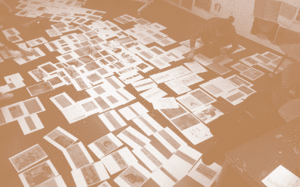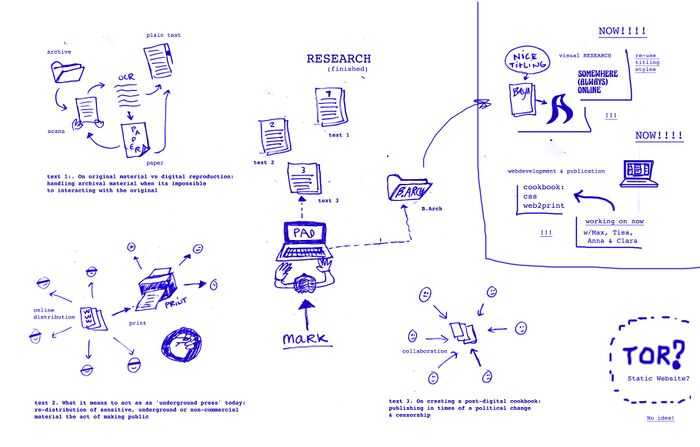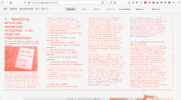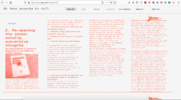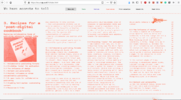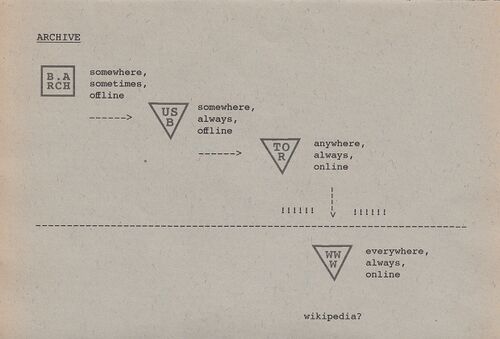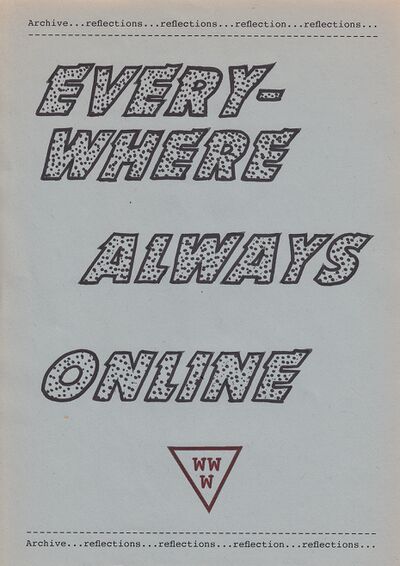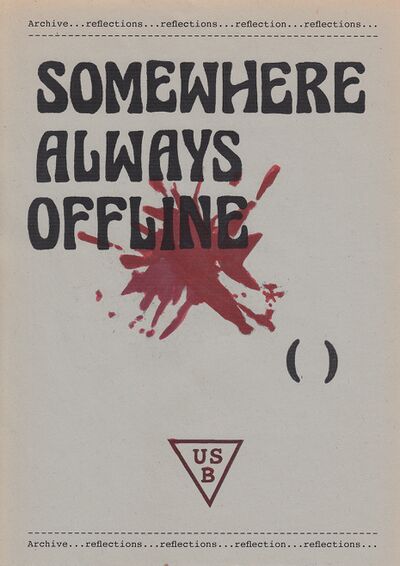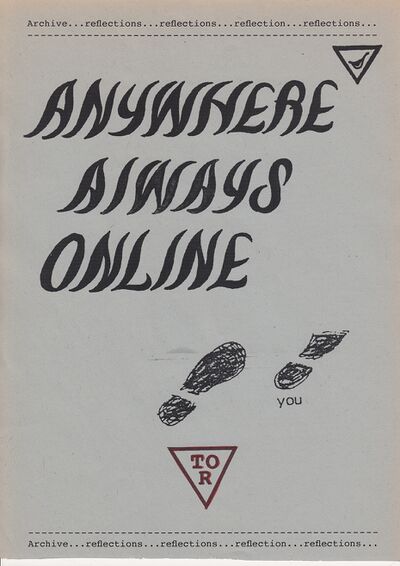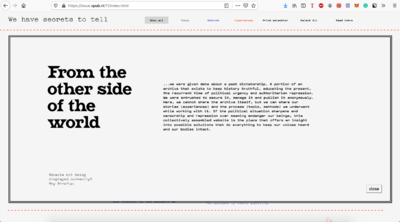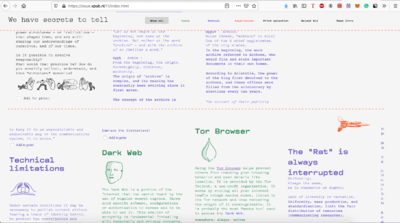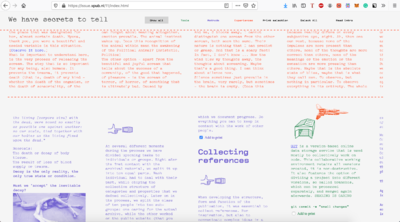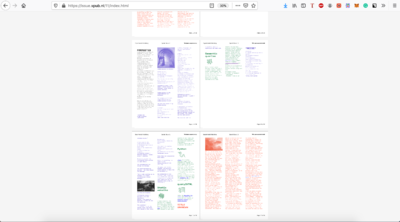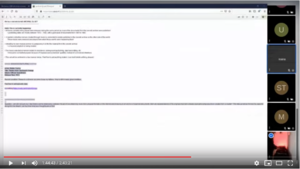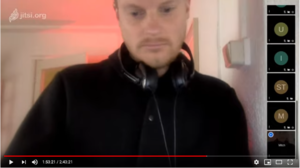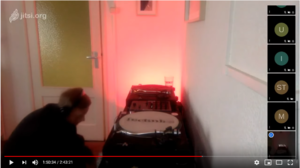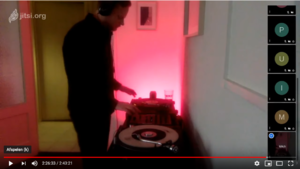User:Markvandenheuvel/specialissue11: Difference between revisions
| Line 16: | Line 16: | ||
====Intensive #2==== | ====Intensive #2==== | ||
https://pad.xpub.nl/p/2020-02-10 | https://pad.xpub.nl/p/2020-02-10 <bv> | ||
[[File:Polyptych.gif|300px | [[File:Polyptych.gif|300px]] | ||
====Intensive #3==== | ====Intensive #3==== | ||
Revision as of 17:26, 19 April 2020
Special Issue #11
Pads
https://pad.xpub.nl/p/publication11_CONTENT
https://pad.xpub.nl/p/publication11
Intensive & Redacted
Intensive #1
- adjacencies
- Slow reading session of Archive Fever bt Derrida (thesis,> teknhe,nomos)
- the notion of forgetting is hard to archive
- 'archiving by nature is excluding'
https://pad.xpub.nl/p/postdigitalitchINTENSIVES
Intensive #2
https://pad.xpub.nl/p/2020-02-10 <bv>
Intensive #3
https://pad.xpub.nl/p/SP11onlineintensive3
- What kind of writing is needed for the project?
- Is it collective/individual writing?
- How can we activate forms of swarm-theory in our writing?
- What does the publication look like and how does it function?
Post-Redacted
https://pad.xpub.nl/p/monday-17-02-2020
https://pad.xpub.nl/p/websitevisions
WORKSHOPS
Workshop MaydayRooms (20-21.01)
https://pad.xpub.nl/p/Maydayroom
Workshop C.N (4-2-2020)
Session with Jérémie Zimmermann
Tor Hidden Service & online publishing anonymously
https://pad.xpub.nl/p/11-3-20
Self-directed Research
Publication Text
Introduction
The following texts are intended to function as short insights on what one might encounter when handling a digital archive, especially without having the opportunity to interact with the original physical material. It might (since in my case at least it involved sensitive, sometimes explicit material) lead to a disconnected feeling towards the content; a disconnect that I could not quite put into words.
To face this complex relationship, I started to research the following notions:
1. Handling archival material – original v.s. digital reproduction:
dealing with archival material when it's impossible to interact with the original
2. Re-opening the boxes – echoing subversive thoughts:
the redistribution of sensitive, underground or non-commercial archival material
3. Recipes for a 'post-digital cookbook':
exploring collaborative forms of publishing subversive content today
1. Handling archival material: original v.s. digital reproduction
Dealing with archival material when its impossible to interact with the original
1.1 Paper as a medium
1.2 The repeatability of print (and why we trust it)
1.3 The human relation to the physical copy
1.4 The materiality of paper
1.5 The ambiguous state of scanned documents
1.6 The aura of the original
1.7 The 'clumsiness' of scanned material
1.8 How format and layout create memories
1.9 Activating archival material
1.10 Scanning as an act of resistance
Key questions in this section:
- What is the message of a simulated medium?
- How does scanned material relate to experiencing emotional and physical distance of content?
1.1 Paper as a medium
Even before the Gutenberg* press changed the world, publishing on paper already had a huge impact on the way that knowledge and information was spread. With the current advent of digital publishing possibilities, the meaning of paper as a medium has changed. Since it has become normal to read digital and volatile screen-based content, questions that arise are the following: How does this affect our relation to the physical material that is still everywhere around us? How does it shape the collective memory? What is its importance in publishing subversive (activist) content?
In The Myth of the Paperless Office (MIT Press 2001), Abigail J. Sellen and Richard H. R. Harperin refer to the paper medium as a 'physical conductor': "Through the gestural act of passing the printed product from one person to the next, paper may be seen as a conceptual ‘conductor’: able to transfer the metaphorical ‘energy’ it contains." What does this mean in the case of handling and distributing scanned (archival) material? What is 'the message' of a digital representation of a medium? Does it reduce this so-called metaphorical ‘energy’?
Gutenberg press revolution: "In the mid-15th century, Johannes Gutenberg of Germany introduced a new concept that would make the process of printing books more efficient. With his invention of the printing press, which utilized movable text, thousands of pages per day could be printed. This process increased development in science, art and religion, increasing the amount of shareable knowledge and decreasing costs so more people had access to it." (source: https://www.whipcord.com)
1.2 The repeatability of print (and why we trust it)
The human attachment to the tangible is nested in our habits of consuming information by reading. Print on paper has a history of significantly contributing to spreading knowledge, opinions, news reports, counter-arguments, and therefore creating collective memories, a trace of time captured within the material. As Marshall McLuhan noted in Understanding Media: “Repeatability is the core of the mechanical principle that has dominated our world, especially since the Gutenberg technology. The message of the print and of typography is primarily that of repeatability.” The first book that Gutenberg printed was, in fact, the Bible. Here, technology made a significant contribution to the spread of religion across the world.
And in spite of its fragile material characteristics, paper can be around for a very long time. When information is printed, the content never changes. Only our interpretations do. Comparing it to digital media that can be found on the web, print is much more stable and static and faithful. But if influential technologies change our habits, let's assume this sense of stability and faithfulness is currently changing since screen-reading is already the standard for many.
1.3 The human relation to the physical copy
So, why are we, in a society which is almost entirely networked and screen-based, still printing and transforming digital text into physical copies? Print has some unique characteristics that are still not overthrown by any other format or medium. The space that printed documents, books, archival material, etc. takes is real. It has mass and a certain weight. The more you store, the less physical space you have available.
This is in fact fundamentally different than the materiality of the text that appears on your screen or a file of a document that is stored on your hard drive. The sensory perception, intrinsic to human beings, is not something that is simply going to disappear. This feeling of disconnect, caused by a distorted sensory perception, is what I encountered while handling the digital scans of archival material. (In my case, the contents of the archival material was often explicit, graphic, politically sensitive and sometimes highly personal in nature, which most likely made this relationship even more complex.)
1.4 The materiality of paper
There is still no electronic device that fully closed the gap to paper. Paper is foldable and can quickly adjust to different reading methods and activities. It's easy to share it in person which creates human encounters. It's very flexible for note-taking and juxtaposing to other material.
No matter how high the quality of the reproduction is, some essential questions can be hard to answer when the physical original is absent. For example, what type of paper, printing techniques, ink, etc. were used? All these properties can give much more detailed information on the time in which the original was produced, what the political state was back then, who produced it, etc. Material such as paper has significant 'flaws': it's very much prone to decay, amongst other weathering risks. When archiving, conditions such as temperature, humidity, and fire safety should be optimal for the preservation of the material.
Scanning seems to be the most preservable option available now. While the physical conductor is dematerialized or lost, the message and the information that the material holds are preserved. What does this mean for the metaphorical ‘energy’? Does this get lost as well? Or will this be saved and therefore stored into the digital reproductions?
1.5 The ambiguous state of scanned documents
In a way, the image of a scan is ambiguous; a scan is a representation of the original, tangible material. A scan finds itself somehow trapped in between the physical and the digital space. It may nonetheless reveal something about its age, the interactions it had with humans over time. A scan is something that you cannot touch, smell, fold or burn. But the mere presence of a scan proves that the original material exists, or existed. It is a carrier that enables information to be made visible, which in turn activates a feeling of trust.
When we face the material by only seeing these scans on our screens, a desire for space emerges. We wish to experience a situation of using an actual magnifying glass instead of a zoom function on your computer to enlarge a certain part of the material, ending up seeing fibers instead of pixels. The physical act of going to the material allows different ways of intuitively interacting with the material, instead of having to use a digital interface full of symbols of tools to explore and navigate through the material. Digital spaces leave less room for a messy, intuitive approach that would, in turn, bring different results to the process.
1.6 The aura of the original
Because print as a carrier for text has been around for so long, it 'has always been perceived as a stable extension of human memory', we are used to the fact of believing that once a text is printed, its content is fixed forever. We interpret it as 'being real and permanent'. It somehow obtains an 'aura'. The reproduction is like a ghost of the aura; trapped somewhere in between the physical and the intangible world.
On Wikipedia, it is stated that "when the word 'aura' was used by the cultural philosopher Walter Benjamin to compare an original artwork to the reproduction, he said that "even the most perfect reproduction of a work of art is lacking in one element: Its presence in time and space, its unique existence at the place where it happens to be"; and that the "sphere of authenticity is outside the technical [sphere]" of the reproduction of artworks. Therefore, the original work of art is an objet d'art independent of the copy; yet, by changing the cultural context of where the art happens to be, the mechanical copy diminishes the aesthetic value of the original work of art."
1.7 The 'clumsiness' of scanned material
In terms of quality, usability, and readability, a scan can be perceived as 'clumsy'. When a document is scanned to retrieve only its textual content, present visual information can be redundant, disruptive and highly impractical for processing. However, these additional visual presences can in fact be perceived as its strength. An image of a scan usually testifies to the manual act that was performed in the creation of the image - it can reveal extra visual traces such as folds, crooked frames, and even hands trying to keep the pages flat while pressing the material against the glass surface of the scanner. Compared to the plain (or OCR-ed) text, it reinforces the fact of the physical existence of the original.
Scans, compared to plain text, also add episodical data such as folds, pencil underlines, marginal notes, censorings, spills, signatures, stamps, stains to the original content. This uncovers an intimate history of the material, its life from before it was scanned. It is a narration that tells us about everything the material had to go through to be preserved - or: not to be destroyed.
1.8 How format and layout create memories
To some extent, our visual memory can be used to retrieve information from a document. We can remember a certain layout, a typeface, color use and type of paper, which connects the specific document to episodic data, related documents, a time in history, etc. A certain format or layout can tell us a lot about the content. Some documents can be visually distinguished from others, based on our knowledge of a tradition of a specific (historical) expression within a text, a poem, an article, a letter, a report, an academic paper, etc.
This can also be applied to digital publications and media. Websites, email conversations, blogs also have certain recognizable visual characteristics that can be stored as well. This also provides more context on how the information was produced and what the intention was. (As well the source code can reveal a lot of information.)
When classified digital documents were released during events that took place around Wikileaks, VAULT7, etc., most of the content that was published was embedded (showed) in its original format. Even though it had all the advantages of digital processing options, the plain content was not simply extracted from the source material. Layout, headings, layout, typographic elements were left to add a layer of trust to the textual content. Sometimes, even information such as document numbers or black blocks that censored information contains was added. Also, a lot of emails were in fact printed and scanned. When converting digital text into a physical medium and back it almost creates some kind of hyperrealism: something that is more real than the original. (Is there, in the case of documents that were originally created digitally, an actual difference between the original and a reproduction? Can a digital file even have an 'aura'?)
1.9 Activating archival material
Often, out-of-print material and limited small press editions are somehow hidden in small institutions and private collections. These places have a lot of specialized knowledge about the contextual, historical and other substantive information of their material. Besides that, it is also important for their local cultural environment that the physical material is located in the place or region where it was originally produced and spread. Yet these collections are mostly unavailable online and therefore cannot be used as public sources of knowledge, they are unavailable to the public or hard to access. Often, the reason for that is the absence of a suitable platform for their dissemination or the limited financial resources available. In some cases, owners don't know how to handle material that is sensitive due to a political climate or censorship.
1.10 Scanning as an act of resistance
As we can learn from history, in times of political change the freedom of the press can be under pressure and can even lead to censorship. In these circumstances, scanning and (anonymous) publishing can be an act of resistance. Digital scans of physical documents can be used as a legit source for articles to prevent whitewashing, which Wikipedia describes as "to gloss over or cover up vices, crimes or scandals or to exonerate by means of a perfunctory investigation or through biased presentation of data". Archives that contain marginal (forgotten) documents are essential to keep a collective (cultural) memory alive. There should be no threat to them being erased from history.
Here is why the availability of a (preferably) high-quality digital reproduction is important. It greatly increases the accessibility and reduces the need to visit the location where the physical original material is kept. This is also beneficial for the preservation of the material since physical handling can be risky: documents can get lost or destroyed. Intentionally or not. Although not entirely safe - scanning and storing digitally also reduces the dangers of a collection being endangered/threatened by the forces of nature.
2. Re-opening the boxes: echoing subversive thoughts
The redistribution of sensitive, underground or non-commercial archival material
2.1 Activating archival material and respreading idea's
2.2 Restabilizing unpublished and forgotten material
2.3 Physical distribution of digital data
2.4 Digital Networking advantages
Key questions in this section:
- What if you can't publish because of political change & censorship?
- What if you are not allowed to publish today what you wrote yesterday?
- What are the possibilities of speeding up the printing and publishing process?
- How can you re-enact(ing) the initial publishing gesture, especially from the importance of underground publishing)?
2.1 Activating archival material and re-spreading ideas: echoes and activation
Audiences emerge –or are being created– when things are being shared. In the act of connecting like-minded individuals lies a possibility for building communities to share ideas. This is easily prone to dishonest capitalist systems and (extractive) business models. Appropriating printed material that was meant to mass-inform a large public should not be kept behind paywalls managed by self-proclaimed owners of the knowledge and the material that transmits it. As a matter of fact, this also goes against the nature of the original purpose of independent and underground publishing.
The technological advantages of today can be used to reconsider and improve underground publishing workflows. For example, the digital state allows easy multiplication of material, networking tools allow real-time and remote collaboration, and all kinds of anonymous distribution and file-sharing possibilities are around before possibly converting it into a physical document. Just like the underground press used to function, but make clever use of the benefits and speed of the digital.
Examples on the impact of alternative press:
(Both excerpts are taken from Post-Digital Print: The Mutation of Publishing since 1894 by Alessandro Ludovico)
André Breton, one of the founders of the 1920s Surrealist art movement, famously declared: “One publishes to find comrades!” This short statement brilliantly embodies the spirit of early avant-garde publishing, as well as that of independent publishing later in the 20th century. Strictly speaking, the main concern here is neither commercial success, nor the aesthetic purity of the printed experiment, nor even the archiving of works (at least not yet). Rather, this kind of publishing is all about fostering and spreading ideas among like-minded people, through the ‘viral’ communication model so often applied by the alternative press.
Another case in point is the body of work of the Ranters, a radical group which flourished during the second half of the 17th century, with heretical views on religion (if Jesus is in everyone, who needs the Church?), politics (expropriation of the rich and collective ownership of property) and sex (preaching an ideal of free love). Such an extremist rebel group (which counted a few thousand followers in London alone) could easily self-publish and distribute its pamphlets. Though such publications were banned and burned, it was much more difficult to destroy an entire printed edition than had been the case with manuscripts, because of the sheer number of copies as well as their widespread distribution – and so some copies survived, a few even to this day.38 The two major political revolutions of the 18th century were both preceded by a frenzy of intellectual self-publishing activity, including a few ‘underground’ bestsellers. In the case of the French Revolution, many of the countless pamphlets produced were sponsored by printers, based on their potential commercial success.
2.2 Restabilizing unpublished and forgotten material
The networking advantage of digital documents allows it to (re)print unpublished and possibly forgotten material and turn it into physical stable objects. In that way, printing on demand is similar to photocopying and mimeography (stencil printing) from the '80s and '90s. Because these methods were relatively cheap and easy to distribute content, alternative presses, underground and self-publishing flourished and became a popular way to target audiences and sub-cultures.
The fact that many people still choose to own a printed object tells us that a physical copy is still an essential experience to consume information. Paper has some specific qualities and characteristics that are not yet defeated by the benefits of the digital. Print-on-demand services and being able to print documents yourself at home perfectly illustrate our resistance to an all-digital world. We can fold it, cut it up for clippings, draw on it and re-use it for other types of usage. Again, this shows that our entanglement to the physical object can't be put aside just like that.
2.3 Physical Distributing of digital data
While the internet can be used to easily transfer and share data, physical exchanges of digital data are used for all kinds of reasons. Methods such as 'sneakernets' create a direct relationship between the users, creating an interpersonal human interaction. They are still being used today because of various security considerations that people face. Depending on the underlying purpose, distributing online or via physical storage media, both have advantages and disadvantages.
Sneakernet is an informal term for the transfer of electronic information by physically moving media such as magnetic tape, floppy disks, optical discs, USB flash drives or external hard drives between computers, rather than transmitting it over a computer network. (source: https://en.wikipedia.org/wiki/Sneakernet)
2.4 Digital Networking advantages
Because of the advantages of publishing online, lots of publishers still only sell hard copies of releases due to reasons such as nostalgic motives, political statements against the 'everywhere always online' omnipresence of our current society, or because they want to control the appearance of their product. In addition to satisfying our reading habits, editions can be collectible because of their physical characteristics such as printing techniques, book design, layout, binding, choice of paper, special finishing, etc.
These choices affect how we read, receive the message and value it. Although the possibilities of professional printing and finishing techniques are getting more accessible due to technological development, they are often limited in customization and design options as they are marketed as practical solutions for the office environment.
3. Recipes for a 'post-digital cookbook':
Exploring collaborative forms of publishing subversive content today
"In a time where it's possible to freely transfer gigabytes of files over a wireless network within a couple of minutes, an archive of sensitive material was brought to us on a USB stick, hidden in a bag which was transported by a human through the air on a 17-hour flight."
3.1 Collaborative publishing formats
3.2 Providing 'tools' for activation
3.3 The influence of design
3.4 Content and personality
3.6 Digital influence on zines collaborative publising
3.7 On open tools for collaborative publishing
3.8 Creating hard copies: customising content
3.9 Recources & links
Key questions in this section:
- What collaborative formats can be used to embrace a variety of content?
- What are the benefits of digital publishing combined with printing?
- What are the options for customization of content?
- How to collaborate and publish with others?
- What if this content won't ever be accessible again from tomorrow?
3.1 Collaborative publishing formats
When exploring all kinds of publishing formats and frameworks that embrace various types, styles of content and voices, one inevitably encounters the so-called 'zine' and 'cookbook'. Even though they come in various shapes, both have been used and proven to be a successful form for activating, creating communities, and spreading non-commercial ideas. Ever present as a hearable voice that flows in counter-current to popular opinions and media.
A Cookbook is some kind of handbook with 'recipes' used for DIY and subversive practices with the aim of getting people involved by handing them tools and techniques to use themselves, often within activist and political groups. A Zine is a small-circulation self-published work of original or appropriated texts and images, usually reproduced via a photocopy machine. Zines are the product of either a single person or of a very small group and are popularly photocopied into physical prints for circulation.
3.2 Providing 'tools' for activation
A publication that was, and is still influential today was The Whole Earth Catalog. Published by Stewart Brand regularly between 1968 and 1972, all kinds of informative tools, how-to's, maps, journals, courses, equipment, computers, and even synthesizers, etc. were provided. Brand had a strong ideological motive making all kinds of knowledge accessible. The idea of the publication was focussed on how to guide the reader to become self-reliant. Rather than selling, a large number of products which (were tested and therefore) proved to be qualitative and sustainable were recommended. While the book was strictly speaking confined to being a catalog, it also consisted of experiences, suggestions of readers/users as well as the Catalog's staff. This interaction between publishers and users sharing information made the format of the Whole Earth Catalog a network by itself.
3.3 The influence of design
One notable aspect of alternative press material such as zines and cookbooks is how the design can add a striking 'voice' to a publication. When thinking about old activist documents, a mental image pops up in our heads immediately. Besides the use of illustrations and photography, the design and layout can strongly affect how information is perceived. A layout gives a certain expression to a page; it can emphasize or even contradict the content.
In the current state of home-printing, standardized paper sizes, limited binding options. Home-printing documents are visually often indistinguishable from each other. Same paper color, texts in black ink. The same can be said for digital libraries and how texts are often being displayed on e-readers.
3.4 Content and personality
In the pre-internet world, zines were self-published and distributed publications to target small (obscure) audiences and create a network to like-minded people. To reduce costs, they were often photocopied and distributed physical prints for circulation in sections of Libraries and by mail or alternative bookshops, listed in Zines about zines like Factsheet Five*. The content of zines, sometimes provocative and subversive in nature, are often not found in the mass media. (This culture is pretty much alive today in independent publications from marginal communities of artists, poets, (political) activists, feminists, queers, music genre-specific, etc.)
In 'Perzines' or personal zines, the content was created from intimate stories, anecdotes, comics, photos, and stories about the authors written by others. Often giving the user the feeling to be part of an intimate conversation between close friends. Often designed by using cut-outs and original letters and typewritten documents which added an extra personal layer to the content.
* Factsheet Five was a periodical mostly consisting of short reviews of privately produced printed matter along with contact details of the editors and publishers. In the 1980s and early 1990s, its comprehensive reviews (literally thousands in each issue) made it the most important publication in its field, heralding the wider spread of what would eventually be called fanzine or zine culture. (source: Wikipedia)
3.5 Digital zines
A Zine can be described as a way of thinking. It is a more or less abstract framework that can hold together all kinds of content from different voices and collaborators. It's flexible, adaptive and, curated or not, assembled based on the content. The role the creators and the readers are diffused and interchangeable as interested people are invited to contribute, distribute and make zines themselves. If a zine has many owners, distribution, in both - digital and analog formats, can be un/decentralized, so takedown is less likely to happen and the content manages to live on.
In the early days of online publishing, electronic zines (a well-known one was called 'PDF-Mags') were created by an underground scene of designers to share free content and showcase creative skills. The main purpose of the downloadable PDF's was to share aesthetic experiments and to create be a platform to publish non-commercial content. Although these zines were not interactive at all, they had a networked function: connecting like-minded creatives. In a much quicker way than the traditional printed zines ever allowed, constrained by their physical medium.
3.6 Collaborative publishing tools
Collaborative digital publishing makes use of the possibility of content being continuously updated and added by its numerous creators. Coming from the ideology and culture that believes that software should be open and accessible, free and open-source software (FLOSS) makes possible the creation of custom workflows that enable people to collaborate on writing, designing and publishing. Here, the role of the writer, reader, and publisher becomes even more diffused.
Networked capabilities such as remote printing, anonymous sharing, peer-to-peer distribution, personal customization can have a huge social and political impact as they can reshape the act of publishing subversive content. For example, new workflows can be used for speeding up a process when there is a need for urgent publishing. A real-time peer-reviewed content editing process and co-authorship can 'single-author-knows-it-all-ideology'. And finally, it can be used to target a certain audience for getting a publication into the right hands.
3.7 Creating hard copies: customising content
Another possibility that web-to-print provides is that it allows the user to select, add and modify content to create a personalized printed copy. In the process of printing a selection of the content that fits your interest, assembling and binding a document can result in adding another personal value to the self-printed material. By these means, one can feel more strongly connected to the physical object. as they have directly participated in its creation.
In ‘The Art of Zines’ (Factsheet Five #63, 1998) C. Becker gives examples on how collective binding methods could function: “The publisher invites contributions and from a few people and each of them sends multiple copies of their work to cover the number of copies in that edition. Each zine copy is then collated and bound making (it) unique, and personalized.”
3.8 On distributing physical documents
One may wonder if the more we are getting used to reading digital and volatile screen-based content, the more we have the urge for tactile physical formats. Not only to cater to our reading habits, but also for human connection and interaction it creates. The original gestural act of spreading printed content as a conductor of ideas and information*, using the possibilities of collaboration and distribution that the digital realm provides.
“In this context, we view the act of publishing as a gesture that accommodates the political, the artistic, and in some cases, the defiant… A gesture is something preceding the action, and therefore signifies motion and agency of the most expressive and potent kind, precisely because it is so wrought with intentionality.” (Muller, N. and Ludovico, A. (2008) ‘Of Process and Gestures: A Publishing Act’ in The Mag.net reader 3 - Processual Publishing. Actual Gestures, OpenMute)
While our trust in print is still pretty much present after all these years of screen reading, we start to experience printed media as slow compared to the online media environment where everything is unsteady and can be constantly updated. As we can see in the changing ways of how we consume news over the past years; with decreasing newspaper sales and the rise of distrust in news.
I personally believe there is a lot to explore in the field of collaborative publishing and what the role of print can be in this. I am in particular curious to what extent or in what situation it is preferable to create physical copies. For me, the methods and tools we used for making this publication gave a whole new insight on how to shape collaborative publishing processes and change more traditional roles for production and distribution. Opening up the process to the extend so that it becomes customizable for a certain intention, means or strategy to target or create a specific public.
3.9 Resources
Imagine this: tomorrow the internet is down. These hyperlinks below will be inaccessible and therefore useless. All the bookmarks to external references will lead you to blank pages. While the internet seems as a stable way of global communication, its centralized infrastructure is also its weakness.
Mark van den Heuvel, 2020
(Edited by Tisa Neža & Sami Hammama)
https://mashable.com/article/myspace-data-loss/
http://blog.bjrn.se/2020/01/non-realtime-publishing-for-censorship.html
https://en.wikipedia.org/wiki/The_Work_of_Art_in_the_Age_of_Mechanical_Reproduction
https://tlockyer.wordpress.com/2011/07/18/achives-why-digital-needs-physical/
https://monoskop.org/images/0/09/Brand_Stewart_Whole_Earth_Catalog_Fall_1968.pdf
https://monoskop.org/images/a/a6/Ludovico,_Alessandro_-_Post-Digital_Print._The_Mutation_of_Publishing_Since_1894.pdf
https://literariness.org/2018/02/19/analysis-of-derridas-archive-fever/
https://en.wikipedia.org/wiki/Liberation_News_Service
https://en.wikipedia.org/wiki/Factsheet_Five
http://blog.bjrn.se/2020/01/non-realtime-publishing-for-censorship.html
https://tlockyer.wordpress.com/2011/07/18/achives-why-digital-needs-physical/
https://loweringthebar.net/2013/09/google-might-need-to-re-scan-platos-laws.html
http://www.ocopy.net/wp-content/uploads/2016/08/dockray_the-scan-and-the-export.pdf
https://en.wikipedia.org/wiki/Liberation_News_Service
https://en.wikipedia.org/wiki/Whitewashing_(censorship)
https://cloudhesive.com/blog-posts/pentagons-use-of-floppy-disks-probably-safer-than-newer-technologies/
https://en.wikipedia.org/wiki/The_Anarchist_Cookbook
PAD to definitive text
https://pad.xpub.nl/p/mark11-edit
- text on website
Texts for typographic illustrations
Archive (B.arch) - physical documents one place
- somewhere, sometimes, offline
Digital archive on USB
- somewhere, always, offline
- TOR hidden service (single jpegs)
- anywhere, always, online
WWW, internet, publically available common resource
- everywhere, always, online<
Typographic Illustrations
Publication Website
https://issue.xpub.nl/11/index.html
Polyptych Dj-Set
Link: https://youtu.be/T-desHKiOQo?t=6206
We have secrets to tell: ARCHIVAL DJ-SET ------------------------------------------------------------- Hello! This is currently happening: • All tracks currently being played were released during the same period as most of the documents from the (secret) archive were published > publishing dates are mostly between 1972 – 1992, with a giant peak of documents from 1981 to 1985 • A western collective memory created through music is connected to events published in the (secret) archive on the other side of the world: "These tracks were released and played here when those events were happening there" • Activating my own musical archive by juxtaposing it with the material from the (secret) archive > a musical polyptych is being created • The music selected somehow relates to resistance, underground publishing, data transmitting, etc. > It became somewhat popular because of 'wayward and subversive' qualities instead of commercial intentions. • This set will be archived in a live manner below. Feel free to add anything related. (Just don't delete anything, please!) >>>>>> NOW PLAYING <<<<<<<
- Archival Dj-set

